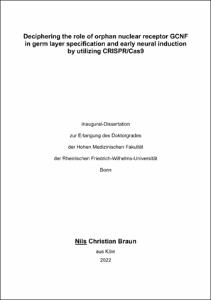Deciphering the role of orphan nuclear receptor GCNF in germ layer specification and early neural induction by utilizing CRISPR/Cas9

Deciphering the role of orphan nuclear receptor GCNF in germ layer specification and early neural induction by utilizing CRISPR/Cas9

| dc.contributor.advisor | Brüstle, Oliver | |
| dc.contributor.author | Braun, Nils Christian | |
| dc.date.accessioned | 2022-02-07T15:54:25Z | |
| dc.date.available | 2022-02-07T15:54:25Z | |
| dc.date.issued | 07.02.2022 | |
| dc.identifier.uri | https://hdl.handle.net/20.500.11811/9601 | |
| dc.description.abstract | Nuclear receptors are widely recognized as an important layer of transcriptional regulation and are usually activated by a signaling molecule. Nuclear receptors without a known ligand are designated orphan nuclear receptors. One of those receptors is GCNF. Whereas it is known that GCNF serves an important role in gonad development and its impact on silencing OCT4 upon differentiation of hPSCs is widely appreciated, less is known about its implication in germ layer specification and early neural induction. To tackle this question, the CRISPR/Cas9 technology was used to generate GCNF-deficient hiPSCs. All quality checks like stable pluripotency marker expression, as well as assessment of genomic integrity by SNP analysis, were passed successfully by the GCNF-deficient hiPSC clones. In self-renewing conditions GCNF ablation could be confirmed on mRNA as well as protein level. An undirected embryoid body-based differentiation experiment combined with a TaqMan-based analysis of differentiation potential, pointed towards an impaired ectodermal differentiation during germ layer specification. To investigate the impact of GCNF-deficiency more specifically on neuroectoderm formation, a directed neural induction experiment with GCNF-deficient hiPSC clones was performed and assessed by RNA-seq, qRT-PCR and immunocytochemistry. This approach revealed candidate genes that might be key players in GCNF downstream signaling. While OCT4 and CRIPTO, two known GCNF target genes, were found to be upregulated, the expression of key factors of early neurodevelopment like PAX6, FEZF2 and FOXG1 were significantly impaired upon GCNF ablation. Additionally, upregulation of WNT4 and reduced RSPO3 expression indicate GCNF being involved in WNT signaling. For future ChIP-seq experiments to identify GCNF target genes, CRISPR/Cas9 technology was utilized to generate hiPSC lines with ChIP-compatible tags (FLAG and AM) added to the C-terminus of the endogenous GCNF gene. In summary, CRISPR/Cas9 technology was successfully employed to generate an isogenic set of GCNF-deficient hiPSCs, that revealed a developmental impairment during germ layer specification and early neural induction. | en |
| dc.language.iso | eng | |
| dc.rights | In Copyright | |
| dc.rights.uri | http://rightsstatements.org/vocab/InC/1.0/ | |
| dc.subject.ddc | 610 Medizin, Gesundheit | |
| dc.title | Deciphering the role of orphan nuclear receptor GCNF in germ layer specification and early neural induction by utilizing CRISPR/Cas9 | |
| dc.type | Dissertation oder Habilitation | |
| dc.publisher.name | Universitäts- und Landesbibliothek Bonn | |
| dc.publisher.location | Bonn | |
| dc.rights.accessRights | openAccess | |
| dc.identifier.urn | https://nbn-resolving.org/urn:nbn:de:hbz:5-65349 | |
| ulbbn.pubtype | Erstveröffentlichung | |
| ulbbnediss.affiliation.name | Rheinische Friedrich-Wilhelms-Universität Bonn | |
| ulbbnediss.affiliation.location | Bonn | |
| ulbbnediss.thesis.level | Dissertation | |
| ulbbnediss.dissID | 6534 | |
| ulbbnediss.date.accepted | 21.12.2021 | |
| ulbbnediss.institute | Medizinische Fakultät / Institute : Institut für Rekonstruktive Neurobiologie (IRN) | |
| ulbbnediss.fakultaet | Medizinische Fakultät | |
| dc.contributor.coReferee | Schorle, Hubert | |
| ulbbnediss.contributor.gnd | 1260749983 |
Dateien zu dieser Ressource
Das Dokument erscheint in:
-
E-Dissertationen (2059)




